Blog Archives

Speaking of Lord Siva and his own Guru… Siva Yogaswami says:
“He illumines everyone to see
by the light of grace radiating within each being.
His rays also lighten the universe
which is constructed of the five elemental powers. Who can see if the Luminous One wills it not?”
Our Beloved and Revered Satguru Sivaya Subramuniyaswami
Attained Maha Samadhi on November 12th, 2001
Click to read for Details.
Click here to read
Gurudeva’s statement on September 11th
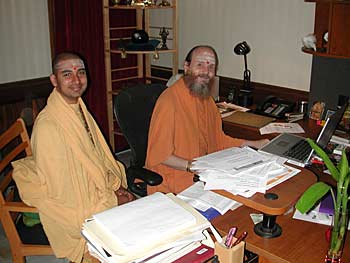
Yogi Mahadeva meets with Bodhinatha. Bodhinatha has for years been our senior administrator handling numerous high level tasks for Gurudeva, now in his new capacity as Satguru Bodhinatha Veylanswami he is working to teach younger monks a lot of things he has done. It will be a long process.
Cybertalk: Consensualocracy was conceived by Gurudeva as a system of
government or management by intelligent cooperation based on a shared vision
and adherence to dharma. It is the preferred way of management in any
religious group, and has ahimsa, nonhurtfulness, at its core. Kauai
Aadheenam and the worldwide missions of Saiva Siddhanta Church follow this
system, which is conducted through meetings where those attending are not
attached, not trying to dominate, and strive to create together something
better than what any single one of them could come up with on their own.
Nonconsensualocracy occurs when someone tries to dominate the group.
Consensualocracy occurs when all are encouraged to express a viewpoint.
Thus, all must avoid getting carried away, forceful or disrespectful but
rather should speak kindly and praise others’ good ideas.
Cybertalk Ends”
For more information about listening to Gurudeva’s talks online and to hear them in other formats, click here.
And click here for an Index to All Past CyberTalks.
Study Gurudeva’s teachings
every day. Visit the Master Course site!
Bodhinatha will be happy to hold “Prasnottara Satsang” — “Questions and Answers” over the telephone with any Hindu religious societies, Hindu youth groups, Radio talk show hosts etc. All you need is a phone with a speaker and an enthusiastic audience. Arrangements may be made in advance by sending email to Sadhaka Mahadevan
If you are experiencing any problems listening to the audio, please to go our Audio FAQ page for sound geeks and follow the directions there.
 |
|
|
 |
||
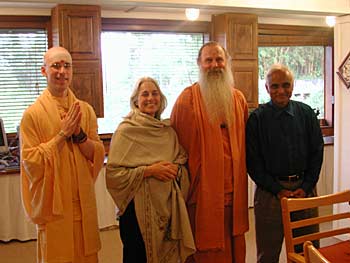
Jinendra Jain visited today from California with his wife Katherine. Professor Jain was Baba Muktananda’s interpreter when Gurudeva and 72 pilgrims visited Baba at his ashram in Ganeshpuri on an Innersearch Travel-Study program in 1972. Paramacharya Palaniswami and Yogi Japendranatha showed him a photo of that moment in which he appeared at Muktananda’s side, previously published in Gems of Wisdom. Jinendra is now an administrator and course leader trainer for Landmark Education.
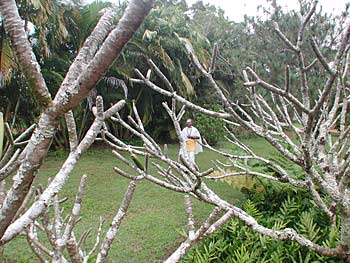
Natyam Tyaganatha, walking through the temple grounds. The plumeria trees are dormant right now and waiting quietly for the warm weather which is slowly coming as the midday temperatures are now rising into the 80’s.

This is Paramacharya Ceyonswami in his office with the Lambodara Kulam feline mascot whose name is Skanda. For many years Skanda was Gurudeva’s personal kitty and after he grew up he started to roam and found a home with the Lambodara Kulam. Lying on a stack of newsprint on this desk is his favorite spot. Meanwhile Paramacharya Ceyonswami is busy dealing with various matter relating to the temple fund raising, pilgrims, monastic health care, jyotisha etc.
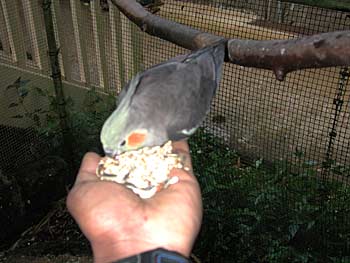
We have a large aviary filled with budgies and cockatails… Some have become quite tame and will feed from your hand. Gurudeva kept a careful watch of how the monks cared for the birds and animals, using it as a tool to help build compassion and a mothering, nurturing selfless spirit.
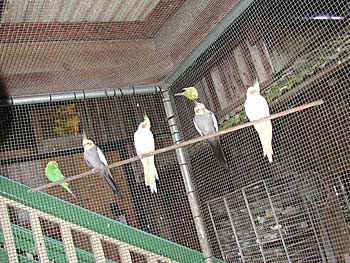
Here they are… lined up waiting for breakfast…

|
Study Gurudeva’s teachings.
|
transcription begins
Date: March_18_2002
Title: Mahasivaratri Talk Part 1 Siva and Muruga
Category: God and Lords of Dharma
Duration: 9 min., 33 seconds
Date Given: March 11, 2002
Given by: Bodhinatha
A number of very fine, devoted Hindu pilgrims visited us the last few days and I have been talking to them. One of them comes from a very traditional Saivite family. His father was a very strict Saiva Siddhantin from Jaffna, who moved to Malaysia and Australia. He focused on the worship of Murugan and focused his children on it too, very explicitly like an Ishta Devata, focusing on Murugan. This man was talking to me and asking about the difference between Murugan and Siva worship, Saivites worshipping Murugan so exclusively and how common that is in Malaysia where he spent many years.
So, I was thinking about that. What is the essential difference between the worship of Murugan and the worship of Siva?
The worship of Muruga of course is very important in our tradition and it is one of the factors that distinguishes the South Indian Saiva Siddhanta form of Saivism. It is not just Siva, Murugan is there too and is very important. But of course Siva is the Supreme Being.
I came up with one major difference and that is the worship of all Deities who are not Siva, is always dualistic. In our tradition, we just have Ganesha and Murugan. It is like, “There is the Deity. Here I am. I am worshipping, I am getting blessed.”
This is good and it is something we all need to master. But our tradition isn’t dualism or theism, it is monistic theism. So there is a monistic side there that is missing when it comes to the worship of Murugan, which is not missing in the worship of Siva. In other words, we start worshiping Siva as we worship any Deity and there is a dualism, there is a separation. We are there beseeching the Deity to bless us. But when we get to a certain point, when those blessings get intense enough we cross over the line into monism. So we are not getting blessed, we are Siva who is blessing. That only happens with the worship of Siva. The Siva worship leads you from separation into unity, from dualism into monism.
Therefore, in Saiva Siddhanta particularly we need to worship Siva. Saiva Siddhanta only works when the focus is on Siva. Some examples of that are how the padas and the margas are described. Of course, we all know them by heart.
The charya pada or the dasa marga, we are quite a distance from Siva. Siva is like the master and we are the servant. We are just getting to know Him. We don’t feel very close in that relationship.
When we go deeper to the kriya pada, temple worship, puja we are closer, we are in the satputra marga, as a son is to a father. So we are a lot closer. The relationship between a son and a father is a lot closer than a servant and a master. We have come that much closer to Siva in understanding, feeling and loving Him.
Next is yoga. Yoga pada is the sakha marga where we are friends. Being friends may seem strange, it seems a little too informal to consider God a friend. Certainly that kind of approach is in many of the traditional Tamil scriptures. Gurudeva himself, would often joke about the Deities and talk about them as His best friends. So it is quite well established in the tradition and it shows the closeness, a real closeness. If someone is a friend, you are very close to them, you share a lot. They are much closer to you than other people.
Of course, in the jnana pada or the San Marga, we are identical, we are Siva. That is our monism in the jnana pada, San Marga. There is no difference between us and Siva in that stage of Siva worship.
There is a beautiful verse, I was hoping someone who can read Tamil in the dark, can read this verse. Any of the stapathis or silpis, can you read it?
uyirrukkuyirai nittral onngnana pujai
uyirrukkoliyai nokkal mahayoga pujai
uyirperum aavaaganam purappujai
seyirkadainesagn sivapujaiyaame
There, that explained it. It is a famous verse. We have used it often. It is in ‘Dancing with Siva’. It talks about each of the padas and what we experience in them. The language is so beautiful, the English just doesn’t catch it. To go along with what we have been talking about, I am going to explain the verse from the end of the verse to the beginning because the verse starts with jnana and then yoga, kriya and charya. We are talking charya, kriya, yoga and jnana. It fits in better when we explain it backwards.
“Expressing adoration is charya.” Attending a puja, expressing adoration is charya.
“Giving life by invocation is external worship of kriya.” This means actually doing the puja. It is like invocation. We are invoking the presence of the Deity in the Murthi. That is giving life. Keep using the word life, it is something you give to the murthi.
“Beholding the Light of life is great yoga worship.” So, we are seeing the inner light just like we were talking about in our Shum meditation. ‘eef tyay’, we call it in the Shum language, seeing the light at the top of the head. It was interesting that Thondunatha translated it as ‘olhi’. This is using the same word ‘uyirukkolhi’, the Light of life is what we behold.
“Being the Life of life is splendorous jnana worship.” That is the Life of life. “God Siva is the Life of your life,” Gurudeva’s phrase. So, there is a separate word in Tamil, with that one meaning, ‘uyirrukkuyir’. God is the Life of your life.
This of course is talking about monism. We are not beholding something. We are not seeing something that is separate from us. “Beholding the light” implies it is separate from us, we are seeing it. We are the awareness seeing the light. We are beholding the light. But here, in “Being the Life of life is splendorous jnana worship”, we are not separate from it. We are just being Siva as the Life of life.
It is a very beautiful verse which shows the whole idea of how our consciousness changes, how our relationship to Siva changes as we progress through charya, kriya, yoga and jnana just in this one verse and it is very beautiful poetry as well.
transcription ends
|
MORE UPLIFTING THINGS |
Innersearch 2002 in Hawaii!
Our next Innersearch Travel-Study program will be held right here on the island of Kauai in the summer of 2002. It’s the first such program on the Garden Island since 1974! From July 17 to July 22 we will enjoy daily classes with the swamis, join in the annual Guru Purnima festival, be inspired by local culture, explore the lush tropical island in exciting and non-touristy ways, and more. Be prepared for a wonderful spiritual experience in paradise with meditations, seminars and sacred ceremonies at the Siva temple of Kauai’s Hindu Monastery. Many have applied already, and there is a limit of 50 participants, so we recommend everyone apply as soon as possible. Interested? Please request an application from pilgrim@searchbeyond.com |
|

|
Check our children and youth section for new items for the young and young at heart! | |
|
1. SIGN OUR GUESTBOOK and receive a FREE GIFT |
||
| 2. Newest Book: LIVING WITH SIVA | ||
|
3. Visiting KAUAI’S HINDU MONASTERY |
||
|
4. Contribute to THANK YOU, GURUDEVA FUND |
||
From Our Gurus' Teachings
Archives are now available through 2001. Light colored days have no posts. 1998-2001 coming later.
